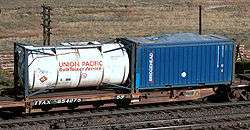Tank container

A tank container or tanktainer is an intermodal container for the transport of liquids, gases and powders as bulk cargo.
Introduction

_%E3%80%90_Container_pictures_taken_in_Japan_%E3%80%91.jpg)
A tank container is built to the ISO standards, making it suitable for different modes of transportation. Both hazardous and non-hazardous products can be transported in tank containers.
A tank container is a vessel of stainless steel surrounded by an insulation and protective layer of usually polyurethane and aluminum. The vessel is in the middle of a steel frame. The frame is made according to ISO standards and is 19.8556 feet (6.05 meters) long, 7.874 feet (2.40 meters) wide and 7.874 feet (2.40 meters) or 8.374 feet (2.55 meters) high. The contents of the tank range from 17,500 to 26,000 liters (3,800 to 5,700 imp gal; 4,600 to 6,900 U.S. gal). There are both smaller and larger tank containers, which usually have a size different from the ISO standard sizes. For example, there are some 27,000 liters (5,900 imp gal; 7,100 U.S. gal) and above litre tank containers in the European swap body fleets in Europe but they are not used on international business only on intra European traffic. The trade organization @TCO estimates that at the end of 2012 the global fleet of tank containers was between 340,000 and 380,000.[1] Most of these tank containers are owned by operators and leasing companies.
There are hundreds of tank container operators worldwide, that can vary on the service they offer. The bigger operators typically offer a wide range of services, while smaller operators may only offer services in one region or with one type of tank.
History
The tank container concept was designed by Bob Fossey,[2] an engineer who worked for Williams Fairclough in London. In 1964 he made a swap body tank for combined transport by truck and train, but this tank was not yet constructed according to ISO standards. In 1966, the first commercial production occurred and one year later the first tank container according to ISO standards was developed. The first mass-produced tank containers were purchased by Trafpak, a part of Pakhoed.
In the early 1970s, the tank container evolved to its current form and the production was also well underway. In the early days, production took place in Europe. In 2010 and afterward, production is mainly in China and South Africa.
Handling

A tank container can be loaded and unloaded from the top and the bottom. On a standard tank container there is a manhole and at least one valve on the top, and there is a valve at the bottom. Loading and unloading is done by connecting hoses of the loading and unloading facility to the valves of the tank. The loading or unloading is often done using a pump. Depending on the installation and regulation of certain products, it is determined how the tank container should be loaded or unloaded.
Types
- Swap body tank - a swap body has a bigger tank which is larger than the frame, usually 23 or 25 feet (7.01 or 7.62 meters) long
- Food-grade tank - a standard tank container which can only be loaded with foodgrade products
- Reefer tank - a tank with the ability to cool the product to be transported
- Gas tank - a tank that is suitable for the transport of gases
- Silo tank - a tank for the transport of grains and powders
- T1 ISO tank container (for wine and light liquids)
- T4 ISO tank container (for non-hazardous edible and non-edible oils)
- T11 ISO tank container (for non-hazardous chemicals)
- T14 ISO tank container (for hazardous chemicals and acids like HCl and zinc chloride)
- T50 ISO tank container (for LPG and ammonia gas)
- SWAP tank container (for cargo above 26,000 to 32,000 metric tons or 25,600 to 31,500 long tons or 28,700 to 35,300 short tons)
- Rubber-lined ISO tank container (for acid-based chemicals)
Competitive modes
See also
References
- ↑ @TCO Report on the number of ISO tank containers, nd
- ↑ [http://www.itco.be/download/history_cpv.pdf (link not found) Huigen Jack and Bob Fossey,30 years of tank containers and tank swap, nd]
